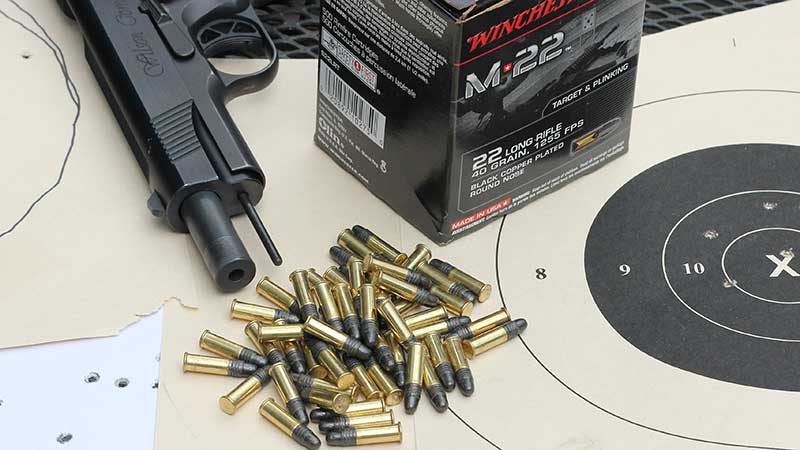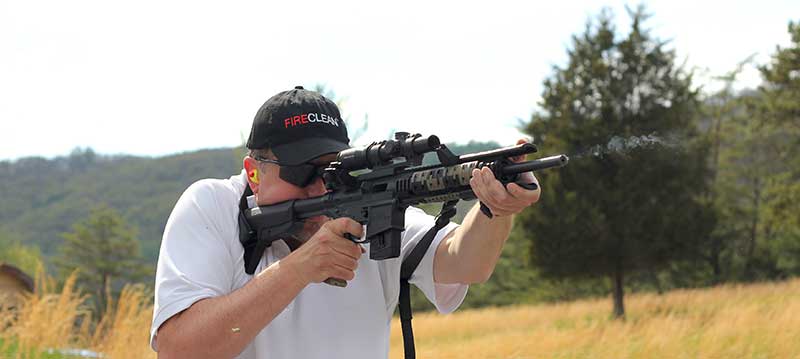
AC020221-Deuce-DD-1-800
I have used subcaliber training to very good effect over the years. However, my approach was best summed up as using the reduced cost of .22 Long Rifle to allow a blunt-force smashing of maximum reps of key skills.
When the ammo drought set in, I went into conservation mode, finding it more advantageous to train limited numbers of reps with real-deal weapons and ammo. As I lucked out and scored some rimfire ammunition, I became much more conscious of how I was spending it.
Over the past year, I have worked up a number of drills that focus on the key attributes rimfire shooting brings to the table, allowing a surgical approach to squeezing maximum good out of fewer rounds, because when you shoot 100 rounds, it may require some time and effort to replace it!
PRECISION
The .22 pistol brings more precision to the table than anything else in your safe. It is rare for a dedicated pistol or conversion to not shoot rings around a service pistol, and it will likely still hold an edge against a match-barreled model. Besides the potential precision, it is tempting to use a definitive term like “everyone” in describing the percentage of shooters who actually shoot the rimfire to a higher standard. It makes a lot of sense to take advantage of this and use it expressly to gain some elevation on the climb to mastery.
My most-used accuracy drill is where a shooter shoots a B8 25-yard target center with five shots in 20 seconds (timed fire) and then again with five shots in ten seconds (rapid fire). Some shooters may immediately question why not use the .22 for slow-fire precision. That is a good and entirely fair question.

Relative lack of blast and recoil, combined with rimfire accuracy, enable shooters to bump their precision up a notch by gaining better trigger break and follow through.

Subcal Timed and Rapid Fire Drill is identical to the 25-yard service pistol drill, with five shots each in 20 and 10 seconds. As shooters get tight, as with this Wilson Combat 1911 conversion, the gains tend to pull centerfire scores up as well.

.22 Long Rifle is slowly becoming more available, allowing shooters to try some tailored drills to get the most out of subcaliber training.
Accuracy without time pressure doesn’t have much of a place in my world. I find it to be a lot like communism: looks good on paper but doesn’t play out well in application. Watch any number of shooters move from slow-fire attempts to timed drills and you see their stance “firm up” and lean in, their focus tighten, and their visage reflect pressure—either aggression to master the task or fear/stress over the constraint. This happens with rimfire too.
This “aggressive accuracy” is what we are looking for, and the rimfire lets the shooter focus more on the fundamentals of firing the shot and less on recovery from recoil or resistance to flinching. The goal is to get a hard focus on perfect sight alignment, feel the shot release cleanly, and see the front sight lift/pistol cycle. Seeing the sight lift is the key component of follow through and the building block of speeding up follow-on shots.
Seeing the action cycle and tracking
sight movement are easier by
a country mile with a rimfire.
Seeing the action cycle and tracking sight movement are easier by a country mile with a rimfire. When the shooter begins to truly see this, the temptation to power slap the trigger diminishes and then the shooter can get a harder focus on the front sight, perfect alignment, and press a clean break through the trigger.
Most shooters struggle to get ten in the black using a centerfire pistol. When those same shooters see more in the black, then all, then more in the ten ring with the .22, their brains register the capability in the self-image “I can do this” box. This tends to drag performance toward that image when the big gun comes back out, as long as the shooter transfers the better execution of technique they learned on the double deuce.
BUNGEE JUMP
With precision coming along, the next drill shifts hard to accommodate speed. The Bungee Jump has the shooter “jump off” with two to three shots to a simple target at seven yards and immediately “snap back” to either an eight-inch steel plate at 25 yards or a two-inch circle on the same target backer, to immediately shift from speed to accuracy.
The shooter starts from the ready and gets the pistol pressed out as quickly as possible to fire a pair into the larger target and then immediately nudges the sights onto the smaller target for a smooth press in a time limit of 2.5 seconds.
Here some may begin to puff up and ready a lecture on recoil control and how a rimfire doesn’t translate to “real” control of the service pistol. Indeed. The object is to acclimate the shooter to breaking shots faster and keeping visual track of the sights at max speed, accepting pretty coarse or downright minimal sight alignment. The shooter must force himself to move at a very aggressive pace while keeping track of the front sight’s travel to make the par time.
This usually requires the shooter to learn to give up a little of the ideal trigger press to gain time. The relative lack of recoil allows the shooter to better sense what is going on with the support hand’s pressure to counteract the additional force of the trigger finger getting busy. The less violent movement of the slide in recoil allows the shooter to see and correlate the effects of rapid trigger technique.

Bungee Jump drill has shooter pushing to ragged edge of speed at 15 yards for two to three shots on the large target (seven yards for pistol), then snapping to the two-inch for a precise shot in 2.5 seconds.
But it doesn’t stop there. The shooter must immediately transition to the more difficult shot and reacquire very solid sight alignment and picture while cleanly pressing a good break. Good skill transfer here is about focusing on the right things.
Shooters who already have good centerfire recoil control skills will get the most benefit out of shooting for a five-inch “easy” target at seven and pushing hard to get three hits before sliding the pistol onto the two-inch target in the 2.5 seconds. This translates very well to the level of control needed to replicate that level of performance with the service gun on an eight-inch circle at speed.
For less experienced shooters who are getting “outgunned” by the drill, I would ease the distance nearer a foot or so at a time until the shooter can make the par time for at least a pair to the larger target and a hit to the smaller 80% of the time. The object is to let the par time force more speed out of the shooter and shove them out of their comfort zone. The shooter who can reliably center-punch the small target with time to spare is ready to add a third shot onto the larger target.
The Bungee Jump very quickly reveals a shooter’s flaws and room for improvement. Are they a good shooter who needs to apply what they know faster? Are they struggling to immediately transition from rat-a-tat to front sight-press? Are there inefficiencies in presentation or control of the handgun that eat up the clock? All of these show up pretty clearly.
The Bungee Jump works very well in a single lane, indoor range format and is an equally good rimfire carbine drill shot the same as described but at 15 yards.
STEPPING OUT
When the shooter has climbed a performance rung or two from the previous drills, the next step is to apply that skill in a more challenging format.
The Bill on the Move is a favored drill that takes the same training emphasis from the larger bungee target and combines it with movement.
The combination of shooting and moving
helps most shooters find another gear
The Bill Drill is the classic practice drill named for Bill Wilson of Wilson Combat. It measures the time for a shooter to draw and fire six shots at max speed onto an IPSC target, with 2.5 seconds often laid down as the marker.
The Bill on the Move takes that approach, but adds movement into the drill. Shooters can choose their movement bracket, but most will be best served initially at seven yards closing to four while firing six shots on the move as quickly as possible.
Many, possibly most, qual courses and competitions that incorporate shooting on the move require a pair. This often leads to shooters adopting truly unnatural gaits and techniques to time shots to certain footfalls. The Bill on the Move forces the shooter to break that, allowing the diminished recoil of the rimfire to force the shooter to keep the weapon firing as they close on the target.
Shooters quickly get over the tendency to overthink the movement and snatch the trigger, both common movement issues, when they are forced to disconnect the movement from the upper platform, which must keep the shots coming. I’ve observed that shooters tend to more closely match the aggressive firing cadence with quicker natural movement rather than the stilted slo-mo stuff you see in many closing attempts for pairs.

Bill on the Move Drill has shooter firing six shots at max speed closing on target in three- to four-yard increments. Steel hanger was shot from 13 to 10 yards. Paper can be safely engaged nearer, with times approaching standard Bill Drill times.

Classic .22 autos such as this High Standard HD-Military can be used if a shooter doesn’t have a conversion. Training benefit is decreased slightly from a dedicated service pistol conversion unit, but the objectives laid out in each drill can still be accomplished and boost the shooter’s skills.
In short order, the shooter can hold an eight-inch circle in very near their static time. The combination of shooting and moving helps most shooters find another gear, as the mental “brakes” on both from overthinking have to be released for the shooter to multitask. More experienced shooters can substitute a five-inch target for even better skills transfer back onto the duty gun.
The Bill on the Move is another great drill for the rimfire carbine trainer. For the carbine, most shooters will find max benefit from the ten- to seven -yard bracket initially and can work back to the 15- to 10-yard line as the drill translates to skill.
LIVE-FIRE VISUALIZATION
High-level athletes have long understood and taken advantage of the power of visualization, the basic idea being that the brain can’t really distinguish between perfect repetitions visualized and those actually performed and in the memory bank. The positive visualization then leads to increased performance on game day.
Subcaliber shooting can have a similar effect. When a shooter is able to shoot more precisely or faster when seriously training with a rimfire, the “personal best” tends to pull overall performance in a better direction.
Give these drills a try and see if they don’t pull you up a notch or two—it’s worth breaking into those precious reserves of Long Rifle!















